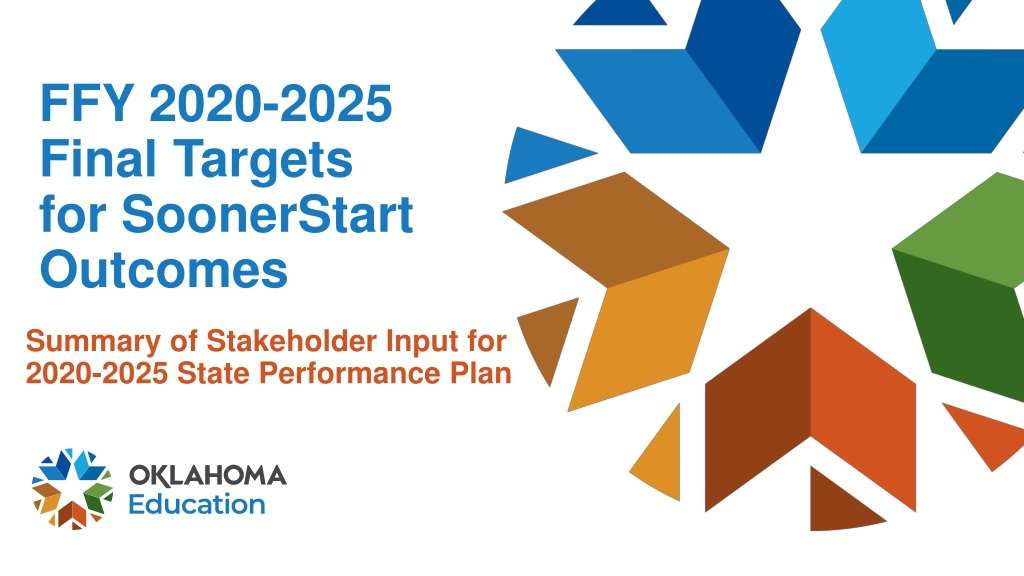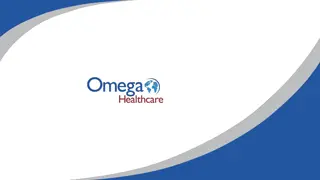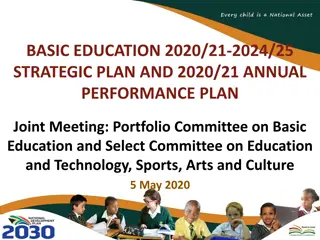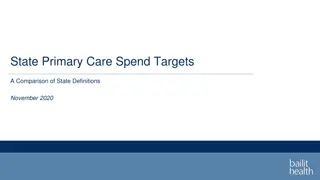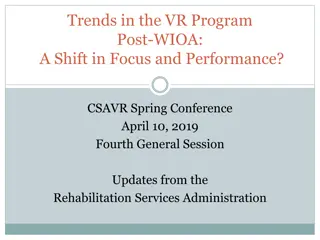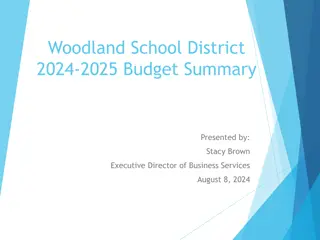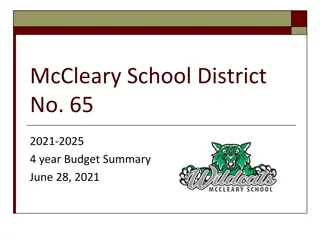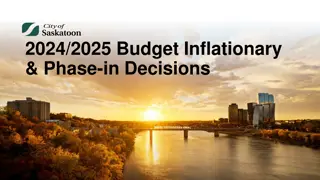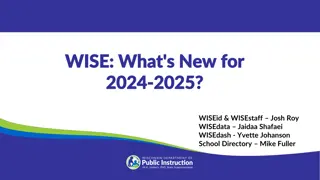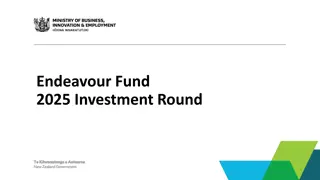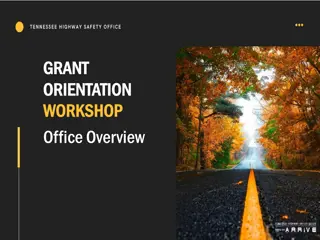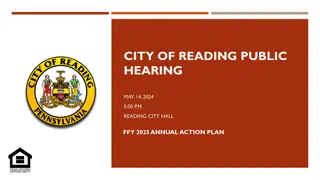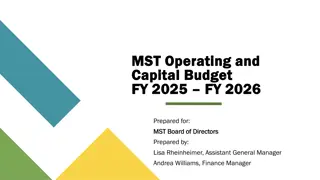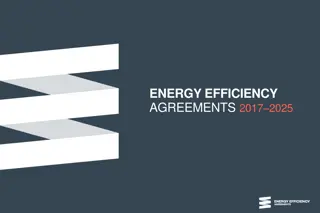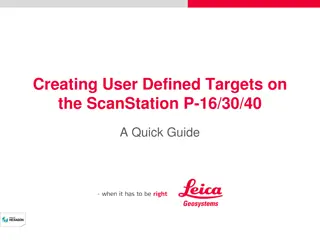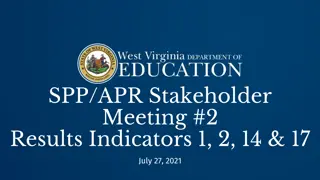FFY 2020-2025 Targets for SoonerStart Outcomes Summary
The FFY 2020-2025 Targets for SoonerStart Outcomes focus on setting goals and milestones for achieving program objectives and child and family outcomes over a six-year cycle. Stakeholder input is crucial in selecting these targets, ensuring continuous improvement and compliance. Stakeholder-approved targets for APR indicators, such as the First Intervention Visit Timeline, outline specific compliance rates and improvements required over the next few years.
Download Presentation

Please find below an Image/Link to download the presentation.
The content on the website is provided AS IS for your information and personal use only. It may not be sold, licensed, or shared on other websites without obtaining consent from the author. Download presentation by click this link. If you encounter any issues during the download, it is possible that the publisher has removed the file from their server.
E N D
Presentation Transcript
FFY 2020-2025 Final Targets for SoonerStart Outcomes Summary of Stakeholder Input for 2020-2025 State Performance Plan
State Performance Plan and Annual Performance Report (SPP/APR) Every six years, IDEA requires states to produce a new State Performance Plan (SPP) with revised/updated targets for achieving program goals and child and family outcomes. Data is collected annually and compared to the target for each of the SPP indicators as a measurement of program achievement. The results are provided to the Office of Special Education Services (OSEP) in the Annual Performance Report (APR). 2 FFY 2020-2025 Targets for SoonerStart Outcomes
Requirements for Targets for SPP Indicators Targets must be selected with diverse stakeholder input. There must be a target for each year of the six-year SPP. Final target at the end of six years must be better than baseline. The target must indicate at least marginal improvement by the end of the six years. OSEP, not each state, determines targets for Compliance indicators that are non-negotiable. 3 FFY 2020-2025 Targets for SoonerStart Outcomes
Stakeholder Input SoonerStart conducted stakeholder meetings in September and October 2021 to review SoonerStart compliance and performance data from the past six years. Based on these discussions, stakeholders proposed incremental and final targets for indicators that require state- determined targets in Oklahoma s State Performance Plan for the next six year cycle. Stakeholder proposed targets were approved by the ICC and posted on the SoonerStart APR Stakeholder webpage. 4 FFY 2020-2025 Targets for SoonerStart Outcomes
STAKEHOLDER APPROVED TARGETS FOR APR INDICATORS 2020-2025 State Performance Plan 5 FFY 2020-2025 Targets for SoonerStart Outcomes
Indicator 1: First Intervention Visit Timeline SoonerStart is required to report on the number of children who received timely services following the development of their Individualized Family Service Plan (IFSP). Timely is defined as the completion of the first intervention visit within 15 working days following parental consent on the IFSP. 6 FFY 2020-2025 Targets for SoonerStart Outcomes
Indicator 1: First Intervention Visit Timeline 100.0% Compliance Rate 95.0% Baseline: 2005, at 96.74% 90.0% FFY 2018 98.62% 99.07% 98.96% Target 100.0% 100.0% 100.0% 100.0% 100.0% 100.0% 100.0% 100.0% TARGET = 100% Target set by Office of Special Education Programs (OSEP) FFY 2019 FFY 2020 FFY 2021 FFY 2022 FFY 2023 FFY 2024 FFY 2025 Data 7 FFY 2020-2025 Targets for SoonerStart Outcomes
Indicator 2: Natural Environment IDEA, Part C requires children to receive the majority of their early intervention services in a natural environment. Natural environments are defined as the child s home or other community settings in which children without disabilities participate. Over the past six years, 96.47% of all SoonerStart services were provided in the natural environment. 8 FFY 2020-2025 Targets for SoonerStart Outcomes
Indicator 2 - Natural Environment 100.0% % Served in Natural 98.0% Environment 96.0% 94.0% Baseline: 2005, at 95.52% 92.0% FFY 2018 95.06% FFY 2019 96.30% 96.00% FFY 2020 98.33% 96.00% FFY 2021 FFY 2022 FFY 2023 FFY 2024 FFY 2025 Data Target 96.00% 96.00% 96.00% 96.00% 96.00% 96.00% 43% of stakeholders responding selected to maintain the target for the next six years at 96.00%. The final target of 96.00% is above the baseline. 9 FFY 2020-2025 Targets for SoonerStart Outcomes
Indicator 3: Early Childhood Outcomes (ECOs) SoonerStart is required to report the percentage of children demonstrating individual growth and the percentage of children exiting the program at peer-level development in three outcome areas: A. Social-emotional skills B. Knowledge and skills (including literacy) C. Behaviors to meet needs 10 FFY 2020-2025 Targets for SoonerStart Outcomes
Indicator 3A: ECOs -Social Emotional Skills Over the past six years, 82.65% of children receiving SoonerStart services for at least six months demonstrated individual growth in social emotional skills and 53.47% of children were functioning within peer level in social emotional skills by the time they exited the program. 11 FFY 2020-2025 Targets for SoonerStart Outcomes
Indicator 3A: ECOs - Growth in S/E Skills 90.0% % with Growth in S-E 85.0% Skills 80.0% Baseline: 2013 at 78.15% 75.0% FFY 2018 84.69% FFY 2019 84.96% 79.00% FFY 2020 84.60% 79.00% FFY 2021 FFY 2022 FFY 2023 FFY 2024 FFY 2025 Data Target 79.00% 79.50% 79.50% 80.00% 80.00% 80.50% 66% of stakeholders responding selected target intervals for the next six years using the historic trend line with no revision of the 2013 baseline. The FY2025 final target is above baseline at 80.50%. 12 FFY 2020-2025 Targets for SoonerStart Outcomes
Indicator 3A: ECOs Peer Level in S/E Skills 55.0% % Peer-level S-E Skills 50.0% 45.0% Baseline: 2020, at 48.70% 40.0% FFY 2018 52.09% 50.20% 48.70% Target 53.0% FFY 2019 FFY 2020 FFY 2021 FFY 2022 FFY 2023 FFY 2024 FFY 2025 Data 53.0% 48.5% 48.5% 49.0% 49.0% 49.5% 49.5% 50% of stakeholders responding selected target intervals for the next six years using the historic trend line based on a revised baseline of 48.70% (FFY 2020 results). The FY2025 final target is above baseline at 49.50%. 13 FFY 2020-2025 Targets for SoonerStart Outcomes
Indicator 3B: ECOs Skills and Knowledge Over the past six years, 85.41% of children receiving SoonerStart services for at least six months demonstrated individual growth in skills and knowledge (including early literacy and communication) and 45.97% of children were functioning within peer level in skills and knowledge by the time they exited the program. 14 FFY 2020-2025 Targets for SoonerStart Outcomes
Indicator 3B: ECOs - Growth in Skills/Knowledge 90.0% % with Growth in Skills & Knowledge 85.0% Baseline: 2013 at 83.04% 80.0% FFY 2018 88.26% FFY 2019 86.09% 84.00% FFY 2020 85.30% 84.00% FFY 2021 FFY 2022 FFY 2023 FFY 2024 FFY 2025 Data Target 84.00% 84.50% 85.00% 85.00% 85.50% 85.50% 66% of stakeholders responding selected target intervals for the next six years using the historic trend line with no revision of the 2013 baseline. The FY2025 final target is above baseline at 85.50%. 15 FFY 2020-2025 Targets for SoonerStart Outcomes
Indicator 3B: ECOs Peer Level in Skills/Knowledge 50.0% % Peer-level in Skills and 45.0% Knowledge 40.0% Baseline: 2020, at 39.90% 35.0% FFY 2018 44.30% FFY 2019 41.19% 47.00% FFY 2020 39.90% 39.50% FFY 2021 FFY 2022 FFY 2023 FFY 2024 FFY 2025 Data Target 47.00% 40.00% 40.00% 40.50% 40.50% 41.00% 50% of stakeholders responding selected target intervals for the next six years using the historic trend line based on a revised baseline of 39.90% (FFY 2020 results). The FY2025 final target is above baseline at 41.00%. 16 FFY 2020-2025 Targets for SoonerStart Outcomes
Indicator 3C: ECOs Behaviors to Meet Needs Over the past six years, 86.42% of children receiving SoonerStart services for at least six months demonstrated individual growth in behaviors to meet their needs and 49% of children were functioning within peer level in behaviors to meet their needs by the time they exited the program. 17 FFY 2020-2025 Targets for SoonerStart Outcomes
Indicator 3C: ECOs Growth in Behaviors 90.0% % with Growth in Behaviors 85.0% Baseline: 2013 at 84.31% 80.0% FFY 2018 86.90% FFY 2019 87.68% 85.00% FFY 2020 86.00% 85.00% FFY 2021 FFY 2022 FFY 2023 FFY 2024 FFY 2025 Data Target 85.00% 85.50% 85.50% 86.00% 86.00% 86.00% 66% of stakeholders responding selected target intervals for the next six years using the historic trend line with no revision of the 2013 baseline. The FY2025 final target is above baseline at 86.00%. 18 FFY 2020-2025 Targets for SoonerStart Outcomes
Indicator 3C: ECOs Peer Level in Behaviors 50.0% % Peer-level in Behaviors 45.0% Baseline: 2020, at 43.70% 40.0% FFY 2018 48.37% FFY 2019 47.23% 48.00% FFY 2020 43.70% 43.50% FFY 2021 FFY 2022 FFY 2023 FFY 2024 FFY 2025 Data Target 48.00% 43.50% 44.00% 44.00% 44.50% 44.50% 50% of stakeholders responding selected target intervals for the next six years using the historic trend line based on a revised baseline of 43.70% (FFY 2020 results). The FY2025 final target is above baseline at 44.5%. 19 FFY 2020-2025 Targets for SoonerStart Outcomes
Indicator 4: Family Outcomes SoonerStart is required to report the percent of families participating in SoonerStart who state that early intervention services have helped their family: A. Know their rights; B. Effectively communicate their children's needs; and C. Help their children develop and learn. Over the past six years, 97% of families reported that SoonerStart helped their family achieve these outcomes. 20 FFY 2020-2025 Targets for SoonerStart Outcomes
Indicator 4: Family Outcomes Measurement Changes SoonerStart has revised the scoring calculation on the Family Survey to indicate a response of highly disagree receives a score of 0 . 67% of Stakeholders responding recommended that the percentage or cut-off score that defines a positive response or approval be increased from 50% to a percentage closer to 60%. 21 FFY 2020-2025 Targets for SoonerStart Outcomes
Indicator 4: Family Outcomes Target Revisions Using stakeholder recommendations, SoonerStart has reset baselines for each Family Outcome statement based on the FFY 2020 survey results calculated with an approval rating of 66% or better. Targets were determined using the new baseline for all three statements. The number of survey questions is not equal for each statement and revising the calculation has resulted in a decrease in the percentages of families with positive responses. SoonerStart feels this correction more accurately reflects the Family Outcomes results. 22 FFY 2020-2025 Targets for SoonerStart Outcomes
Indicator 4A: Families Know Their Rights 100.0% % Approving of SoonerStart 95.0% 90.0% 85.0% Baseline: 2020, at 85.75% 80.0% FFY 2018 - Revised FFY 2019 - Revised 93.68% 96.00% FFY 2020 FFY 2021 FFY 2022 FFY 2023 FFY 2024 FFY 2025 Reported 95.07% Target 85.75% 85.50% 96.00% 86.00% 87.00% 88.00% 89.00% 90.00% 23 FFY 2020-2025 Targets for SoonerStart Outcomes
Indicator 4B: Communicate Childs Needs 100.0% % Approving of SoonerStart 95.0% 90.0% 85.0% Baseline: 2020, at 87.96% 80.0% FFY 2018 - Revised FFY 2019 - Revised 95.87% 96.00% FFY 2020 FFY 2021 FFY 2022 FFY 2023 FFY 2024 FFY 2025 Reported 97.18% Target 87.96% 87.50% 96.00% 88.00% 88.50% 89.00% 89.50% 90.00% 24 FFY 2020-2025 Targets for SoonerStart Outcomes
Indicator 4C: Help Families Help their Child 100.0% % Approving of SoonerStart 95.0% 90.0% 85.0% Baseline: 2020, at 97.54% 80.0% FFY 2018 - Revised FFY 2019 - Revised 99.23% 96.00% FFY 2020 FFY 2021 FFY 2022 FFY 2023 FFY 2024 FFY 2025 Reported 98.24% Target 97.54% 97.00% 96.00% 97.00% 97.50% 97.50% 97.50% 98.00% 25 FFY 2020-2025 Targets for SoonerStart Outcomes
Indicators 5 and 6: Child Find SoonerStart is required to report the percentage of children in Oklahoma who receive early intervention services on an IFSP. The percentages are reported in two categories: A. Birth to One B. Birth to Three 26 FFY 2020-2025 Targets for SoonerStart Outcomes
Indicators 5 and 6: Child Find Percentages Over the past six years, SoonerStart has provided services to approximately .76% of children ages 0-1 and 1.69% of children ages 0-3 annually. This percentage is based on a one-day child count and does not reflect the cumulative percentage of children served each year. 27 FFY 2020-2025 Targets for SoonerStart Outcomes
Indicator 5: Child Find Birth to One 1.0% % Children served 0.8% under age 1 0.6% 0.4% 0.2% Baseline: 2013, at 0.81% 0.0% FFY 2018 0.83% 0.90% FFY 2019 0.77% 0.90% FFY 2020 0.63% 0.63% FFY 2021 FFY 2022 FFY 2023 FFY 2024 FFY 2025 Data Target 0.65% 0.70% 0.75% 0.80% 0.85% 87% of stakeholders responding selected a final target above the 2013 baseline of .81% with incremental increases in target intervals for the next six years. 28 FFY 2020-2025 Targets for SoonerStart Outcomes
Indicator 6: Child Find Birth to Three 1.80% % Children served under 1.70% 1.60% age 3 1.50% 1.40% Baseline: 2013, at 1.66% 1.30% FFY 2018 1.73% 1.70% FFY 2019 1.75% 1.70% FFY 2020 1.53% 1.50% FFY 2021 FFY 2022 FFY 2023 FFY 2024 FFY 2025 Data Target 1.55% 1.60% 1.65% 1.70% 1.75% 68% of stakeholders responding selected a final target above the FFY 2013 baseline of 1.66% with incremental increases in target intervals for the next six years. 29 FFY 2020-2025 Targets for SoonerStart Outcomes
Indicator 7: 45-Day IFSP Timeline SoonerStart is required to report the number of children who had an Individualized Family Service Plan (IFSP) developed within 45 days of their referral to the program. 30 FFY 2020-2025 Targets for SoonerStart Outcomes
Indicator 7: 45-Day IFSP Timeline 100.0% Compliance Rate 95.0% Baseline: 2005, at 96.74% 90.0% FFY 2018 95.40% 99.80% 99.28% Target 100.0% 100.0% 100.0% 100.0% 100.0% 100.0% 100.0% 100.0% FFY 2019 FFY 2020 FFY 2021 FFY 2022 FFY 2023 FFY 2024 FFY 2025 Data TARGET = 100% Target set by Office of Special Education Programs (OSEP) 31 FFY 2020-2025 Targets for SPP/APR Indicators
Indicator 8: Transition Timelines SoonerStart is required to report the number of children who had a: A. Timely Transition Plan on their IFSP B. Timely notification of potential eligibility to their local school C. Timely Transition Planning Conference (TPC) with their local school Timely is defined as at least 90 days before their third birthday. 32 FFY 2020-2025 Targets for SoonerStart Outcomes
Indicator 8A: Transition Initiation Timeline 100.0% Compliance Rate 95.0% Baseline: 2005, at 97.82% 90.0% FFY 2018 96.80% 99.50% 97.39% Target 100.0% 100.0% 100.0% 100.0% 100.0% 100.0% 100.0% 100.0% FFY 2019 FFY 2020 FFY 2021 FFY 2022 FFY 2023 FFY 2024 FFY 2025 Data TARGET = 100% Target set by Office of Special Education Programs (OSEP) 33 FFY 2020-2025 Targets for SoonerStart Outcomes
Indicator 8B: Notification to the LEA Timeline 100.0% Compliance Rate 95.0% Baseline: 2005, at 96.74% 90.0% FFY 2018 96.20% 96.10% 95.75% Target 100.0% 100.0% 100.0% 100.0% 100.0% 100.0% 100.0% 100.0% FFY 2019 FFY 2020 FFY 2021 FFY 2022 FFY 2023 FFY 2024 FFY 2025 Data TARGET = 100% Target set by Office of Special Education Programs (OSEP) 34 FFY 2020-2025 Targets for SoonerStart Outcomes
Indicator 8C: TPC Timeline 100.0% Compliance Rate 95.0% Baseline: 2005, at 96.74% 90.0% FFY 2018 96.00% 95.70% 97.39% Target 100.0% 100.0% 100.0% 100.0% 100.0% 100.0% 100.0% 100.0% FFY 2019 FFY 2020 FFY 2021 FFY 2022 FFY 2023 FFY 2024 FFY 2025 Data TARGET = 100% Target set by Office of Special Education Programs (OSEP) 35 FFY 2020-2025 Targets for SoonerStart Outcomes
Indicators 9 & 10: Dispute Resolution and Mediation SoonerStart is required to report the percentage of hearing requests that went to resolution sessions that were resolved through resolution session settlement agreements (Indicator #9) and the percentage of mediations held that resulted in mediation agreements(Indicator #10). SoonerStart has not held any resolution settlement sessions or mediations in more than six years, including this past year. States are not required to establish baseline or targets if the number of resolution sessions is less than 10. 36 FFY 2020-2025 Targets for SoonerStart Outcomes
Indicator 11: State Systemic Improvement Plan (SSIP) The Office of Special Education Programs (OSEP) requires each state to develop a six-year State Systemic Improvement Plan (SSIP). This is a comprehensive, ambitious, achievable multi-year plan designed to improve outcomes for children with disabilities and their families through system and practice change. 37 FFY 2020-2025 Targets for SoonerStart Outcomes
SoonerStarts SSIP SoonerStart will focus on providing support to improve social emotional outcomes in infants and toddlers using tiered levels of intervention strategies. Build supporting infrastructure Establish and implement evidence-based practices with fidelity Monitor and evaluate child progress and improvement 38 FFY 2020-2025 Targets for SoonerStart Outcomes
SoonerStart State-identified Measurable Result (SiMR) Baseline data indicates that 57.06% of SoonerStart children screened showed no concerns development. SoonerStart s goal is to increase the percentage of infants and toddlers who demonstrate positive social emotional skills after receiving six months of early intervention services. in social emotional 39 FFY 2020-2025 Targets for SoonerStart Outcomes
Indicator 11: State Systemic Improvement Plan 65.0% % Children Showing No 60.0% Concerns in Post- Screening 55.0% Baseline: 2020, at 58.00% 50.0% FFY 2020 58.06% 58.00% FFY 2021 FFY 2022 FFY 2023 FFY 2024 FFY 2025 Data Target 58.00% 59.00% 61.00% 63.00% 65.00% 74% of stakeholders responding expressed support for medium improvement over the next six years with incremental increases in yearly target intervals. Using the baseline data results of 58.06%, SoonerStart proposes a FFY 2020 target of 58.00% and a final target of 65.00% in FY2025. 40 FFY 2020-2025 Targets for SoonerStart Outcomes
COMMENTS OR QUESTIONS? If you have questions or would like to share comments or suggestions, please contact: Lou Anne Mullens, Assistant Executive Director Oklahoma State Department of Education SoonerStart Louanne.Mullens@sde.ok.gov 405-527-5407 41 FFY 2020-2025 Targets for SoonerStart Outcomes
